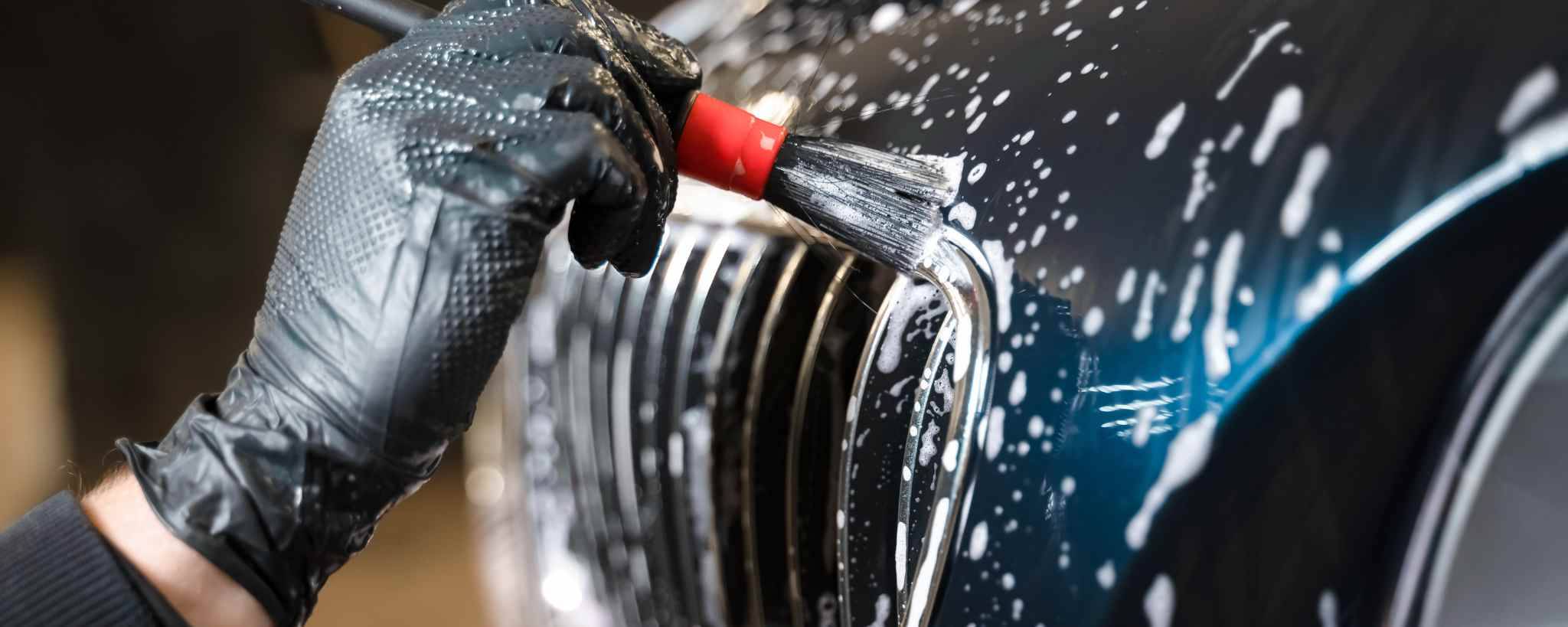How to Clean Grease from Your Car’s Exterior: A Step-by-Step Guide
Tired of untreated grease on the exterior of your car? Here are some easy steps to clean the grease from car exterior!

Use AI to summarize this article:
Grease stains on your car’s hood or doors can be a real headache. Whether it’s road tar from a long drive or engine oil from a leaky gasket, these sticky patches don’t just look bad but also harm your car’s paint over time.
Follow this professional guide to safely remove grease from your car’s exterior and keep it looking showroom-ready.
What You’ll Need to Remove Grease
Before starting, gather these essentials to clean grease from your car’s exterior surfaces, like the hood, fenders, or bumpers. Each tool is chosen to protect your paint while effectively tackling stubborn stains. Here’s what you’ll need:
- Automotive-safe degreaser (like Meguiar’s Super Degreaser) to break down grease without harming paint.
- Microfiber cloths for gentle wiping to avoid scratches on painted surfaces.
- Soft-bristle brush to scrub lightly without damaging the car’s finish.
- Warm water in a bucket to loosen greasy spots on doors or fenders.
- Hose or pressure washer set to a low setting to rinse off dirt safely.
- Clay bar with lubricant (optional) for embedded grease on painted areas.
- Wax or sealant (like Turtle Wax Hybrid Solutions) to shield the exterior after cleaning.
Step-by-Step Guide to Cleaning Grease from Your Car’s Exterior
Note: Work in a shaded area to prevent water spots from forming under the sun.
1. Rinse the Affected Area
Use a hose or a pressure washer on a low setting to rinse the greasy spot on your car’s hood or doors. This removes loose dirt that could scratch the paint during scrubbing. A gentle stream works best to avoid damaging the surface.
2. Apply an Automotive-Safe Degreaser
- Spray an automotive-safe degreaser, such as Meguiar’s Super Degreaser, directly onto the grease stain on the bumper or fender.
- Let it sit for 2 to 5 minutes, following the product’s instructions, to break down the grease.
Avoid household degreasers, which can strip your car’s protective wax.
3. Scrub Gently with a Soft Brush
Take a soft-bristle brush and work the degreaser into the grease stain using light, circular motions. Focus on areas like the doors or hood where grease might cling tightly. Check that no residue remains on the painted surface before moving on.
4. Use a Clay Bar for Stubborn Stains (Optional)
For embedded grease on painted areas like the wheel wells, apply clay lubricant and gently rub a clay bar over the spot. This lifts tough stains without harming the paint. Rinse the area afterward to clear away any leftover residue.
5. Wash and Rinse the Area
Mix a pH-balanced car shampoo in a bucket of warm water. Wash the cleaned area on the doors or bumpers to remove any degreaser residue, then rinse thoroughly with clean water. Make sure no soap or degreaser is left behind to avoid streaks.
6. Dry and Protect with Wax
Dry the area with a microfiber cloth to prevent water spots on the hood or fenders. Apply a wax or sealant, like Turtle Wax Hybrid Solutions, to protect the paint from future grease stains. Buff the surface lightly for a glossy, showroom-quality shine.
Tips for Cleaning Grease from Different Car Surfaces
Different parts of your car’s exterior, like painted doors or chrome trim, require specific care to avoid damage while removing grease. These tips ensure a safe and effective cleaning process for each surface.
💡Always test products on a small area first to confirm they’re safe.
Painted Surfaces (Hood, Doors, Bumpers)
Use a pH-balanced degreaser to avoid stripping the wax on your car’s hood or doors. After cleaning, reapply a protective wax to shield the paint from future stains. This keeps the finish vibrant and resistant to road grime.
Chrome or Metal Surfaces (Grilles, Trim)
A mild degreaser or dish soap works well on chrome grilles or metal trim without causing pitting. Polish the area with a chrome-specific product to restore its shine after cleaning. Avoid harsh brushes, which can leave fine scratches on the reflective surface.
Glass Surfaces (Windows, Windshield)
Clean windows or the windshield with an ammonia-free glass cleaner for a streak-free result. Wipe in circular motions using a microfiber cloth to lift grease without smudging. Skip degreasers here, as they can leave a hazy residue on glass.
Common Mistakes to Avoid When Cleaning Grease
Here are some common mistakes that can harm your car’s finish or make the cleaning process less effective. Pay attention to these warnings for the best results.
- Using harsh household cleaners, like oven degreasers, can dull or strip your car’s paint on the hood or doors.
- Scrubbing too hard with a brush, risking scratches or a dulled finish on painted surfaces.
- Skipping the final rinse leaves degreaser residue on bumpers that can attract more dirt.
- Forgetting to apply wax may leave the exterior vulnerable to new grease stains from road tar or oil.
For tough grease stains or a full exterior refresh, professional detailing services can make a big difference. Experts have the tools and know-how to restore your car’s shine without risking damage to the paint or chrome.
Frequently Asked Questions
Will WD-40 Remove Grease From Car Paint?
Yes, WD-40 can remove light grease from car paint on areas like the hood or doors, as it’s a solvent that breaks down oily residues. However, it may strip wax or leave a residue, so rinse thoroughly and reapply a protective wax afterward.
Can I Use Vinegar to Remove Grease from My Car?
Vinegar’s acidity can dull the paint on your car’s hood or doors, so it’s best to avoid it. Stick to an automotive-safe degreaser for safe and effective grease removal.
What Causes Grease Stains on Cars?
Grease stains often come from road tar picked up during drives, engine oil leaks, food spills, or even the transfer of grease from clothing or hands.
Is a Clay Bar Necessary for Grease Removal?
A clay bar isn’t always needed, but it works wonders for embedded grease on painted surfaces like wheel wells. It lifts stubborn stains that a degreaser alone might miss. Use it with a lubricant to avoid scratching the paint.
How Do I Choose the Best Degreaser for Car Paint?
Look for a degreaser labeled as safe for automotive paint to protect your car’s finish. Avoid products with harsh chemicals that can strip wax or dull the surface. Always follow the manufacturer’s instructions for the best results.

Parham Koukia
Lead Car Detailer / Operations Manager
With nearly 15 years of hands-on detailing experience, Parham has become a trusted authority in the auto care world. His work is regularly spotlighted in leading outlets like CNN, GoBankingRates, and Family Handyman. Parham likes to share his knowledge to offer in-depth tips on equipment selections, seasonal car care, and some secret car cleaning tips used by detailers in the real world!
Read more
